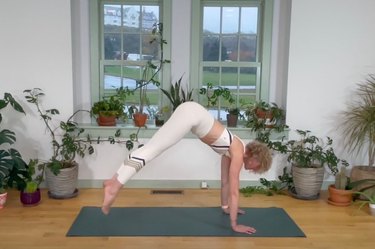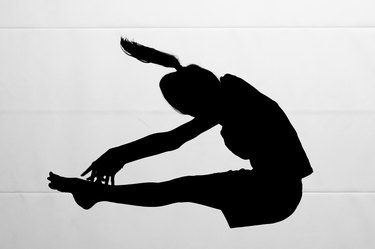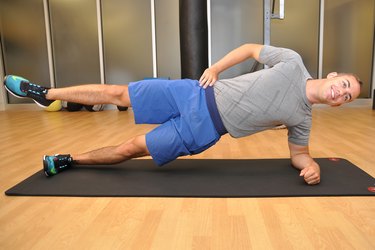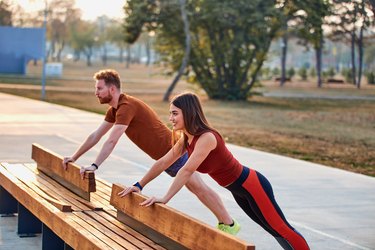

The plank to pike jump is one of those rare ab moves that really works your entire body, all the way from your hands to your toes. It builds strength, cardio and flexibility — all with using just your body weight. That type of efficiency makes it worthy of adding to any fitness routine. Here's what you need to know to do just that.
- What is a plank to pike jump? It's a total-body exercise that involves starting in a plank position, jumping your feet in so that your legs are in a pike and your hips are in the air, and then jumping back out to a plank.
- What muscles does the plank to pike work? While most people think of it as a core-specific move, it truly works your whole body — shoulder muscles, lats, glutes, hamstrings and heart, included.
- Who can do it? Because there are some easy ways to modify this move, exercisers of all levels can do the core-builder, Ashley Patten, founder of Ashley Patten Pilates, tells LIVESTRONG. If you have joint issues or any heart issues, talk to your doctor before doing any jumping or high-intensity cardio.
Video of the Day
How to Do the Plank to Pike Jump With Proper Form
- Start in a plank with your feet together. Keep your core and glutes braced so that your body is straight and forms one long line from head to feet.
- Shift more weight towards your hands and shoulders.
- Keeping your legs straight, use your abs to pull your hips up toward the ceiling and jump your feet forward, landing in a pike position with soft knees.
- Jump your feet back to plank, keeping your core tight and finding the long line again from head to feet.
Watch the Full Plank to Pike Jump Tutorial
4 Pike Plank Benefits
What are plank to pike jumps good for? A lot of things. Here are the top benefits of the pike to plank jump exercise.
1. Core Strength
This move is primarily a great core exercise. Being in a plank works your core in and of itself. Add to it the pike movement, which you should be initiating from your core muscles, and you're definitely going to feel the burn — almost immediately.
Planks target the deepest core muscle, the transverse abdominis, which is responsible for stabilizing the entire trunk. And the pike-up motion hits the rectus abdominis, which are the surface muscles you think of when you think of a six-pack.
2. Shoulder Stability
Planks also give you a legit shoulder workout.
The position primarily targets shoulder muscles, like your deltoids and serratus anterior, which is the muscle along each side of your shoulder blade working to stabilize it. As you jump forward, your shoulders have to work hard to stay stable and resist any temptation to move forward
3. Cardio
It also makes for an intense cardio burn, especially if you pick up the pace at which you jump in and out.
Plus, the sheer fact that the plank to pike jump works so many muscles at once means it automatically cranks up your heart rate as all those muscles start working simultaneously.
4. Total-Body Mobility
And once you do one, you'll realize that piking from a plank position really challenges hamstring flexibility. If you're tight there, it'll limit how far forward you can jump, but the exercise also functions as a dynamic mobility move — helping to loosen up the tight muscles and warm them up for whatever else your workout has in store.
You'll also improve mobility through your hips, shoulders, wrists and even ankles while you're at it.
5 Plank to Pike Jump Technique Tips
1. Perfect Your Plank
The almighty plank is essentially your home base throughout this exercise, so you want to make sure you've nailed proper form.
That means shoulders stacked over your elbows and wrists (not leaning too far forward or back), and your entire body braced so that your back is flat and your body forms one long line from your shoulders to your feet.
Your lower back shouldn't arch or round. Similarly, you want your upper back to be strong so that you're not sinking into your shoulder blades. Actively squeeze your core and glutes.
This is all important to avoid injury and to get the most out of the move.
Related Reading
2. Use Your Core
"Focusing on engaging your abdominals as you jump in and out of your plank will help support your back and maintain the long line from head to feet when starting and finishing each repetition," Patten says.
If you start to feel this move in your lower back, that may be a sign you've dropped your core engagement and need to focus on it more.
Think about keeping the muscles of the core working throughout, and initiating the pike movement from your core each time.
3. Brace Your Shoulders
It can be easy to start to feel a little out of control as you jump forward and back. To maintain control and stability, think about locking your shoulders and hands in place.
"Engaging your shoulders and firmly planting your hands into the floor as you shift your weight forward and back will help to stabilize your shoulders and maintain control of your body," Patten says.
If you feel too much pressure in your shoulders, shortening the range of your jump can help keep you from rocking too far forward.
4. Bend Your Knees if You Need to
Being able to keep your knees straight when you jump in requires some serious hamstring flexibility. If you need to bend them a bit, that's totally OK — and better than forcing it and potentially pulling something.
It'll also help you get a little more range on the jump, which is good for ab engagement and might make it easier to move quicker (hello, soaring heart rate!).
5. Point Your Toes
It may seem like a minor detail, but pointing your toes can make this move more doable, especially if you have tight hamstrings.
If you're flexing your toes, the back of your legs are going to feel even tighter; letting them naturally point will take the extra tension out and make it easier to keep your knees straight.
5 Pike Plank Variations
Move 1: Plank to Pike Leg Lift
Adding a single leg lift between each plank gives your hips and hamstrings some extra work.
"You'll gain not only more flexibility through the back of your hips and legs, but also challenge the strength and stability of both your standing and moving legs," Patten says.
This variation also takes the impact out of the move.
- Start in a plank with your feet together. Keep your abs and glutes braced so that your body is straight and forms one long line from head to feet.
- Keeping your legs straight, walk your hands back toward your feet until your body is in a pike position.
- Holding your body stable, lift one leg toward the ceiling.
- Bring your leg back down to the floor and then slowly walk your hands forward back to a plank position.
- Repeat, this time lifting the other leg. Continue, alternating legs with each rep.
Move 2: Plank to Pike Reformer
When done on the Pilates reformer, the pike plank is called "up stretch," Patten says.
"The main difference between doing this on the mat and on the reformer is that you have both the resistance and the assistance of the springs," she says. "When pushing out to plank, you're pushing out against the work of the springs, creating more resistance. When coming into pike, you have the assistance of the springs pulling you in but are simultaneously resisting the pull of the springs to create more opposition in your body."
This, in some ways, makes the move more challenging. But it also might be a better option if you can't jump, because the impact is removed from the equation. It also allows you to work more on spinal mobility, Patten says.
- Start on a reformer with your hands on the foot bar, your feet against the foot pads on the carriage, and your glutes piked up toward the ceiling.
- With control, push the carriage toward the back of the reformer and bring your torso down into a plank position. Keep your abs and glutes braced so that your body is straight and forms one long line from head to feet.
- Slowly slide the carriage back up to the front of the reformer. Once you get there, pull your hips up and press down through your arms to get into the pike position.
- Repeat this movement, making sure to move with complete control.
Move 3: Plank to Stand
- Start in a plank with your feet together. Keep your abs and glutes braced so that your body is straight and forms one long line from head to feet.
- Step one leg forward underneath your body and set your foot down in between your hands.
- Bring the other foot up to meet it as you stand up straight.
- Keeping a flat back, bend forward at the hips and place your hands back on the floor.
- Step back one foot at a time.
- Alternate the starting leg with each rep.
Move 4: Plank to Knee Tuck
Because this variation doesn't involve jumping, it's a good modification for people who aren't into high-impact moves. It also puts a larger focus on the obliques, Patten says.
- Start in a plank with your feet together. Keep your abs and glutes braced so that your body is straight and forms one long line from head to feet.
- Shift your weight forward slightly as you bring one knee in toward the same side’s elbow.
- Extend the leg back out to a plank position.
- Repeat with the other leg. Continue alternating sides.
Move 5: Plank to Pike Toe Touch
"This variation gives you a great balance of strength and the added bonus of flexibility with the toe touch," Patten says. "It's also great if jumping isn't in your repertoire but you still want to work through the range of motion of a plank to pike."
- Start in a plank with your feet together. Keep your abs and glutes braced so that your body is straight and forms one long line from head to feet.
- Keep your legs straight as you shift your weight back and lift your hips toward the ceiling, so that you’re in a pike position.
- Tap one foot with the opposite hand.
- Shift forward to return to the plank position.
- Repeat, but this time touch the other hand to the opposite foot.
- Continue, alternating sides.


